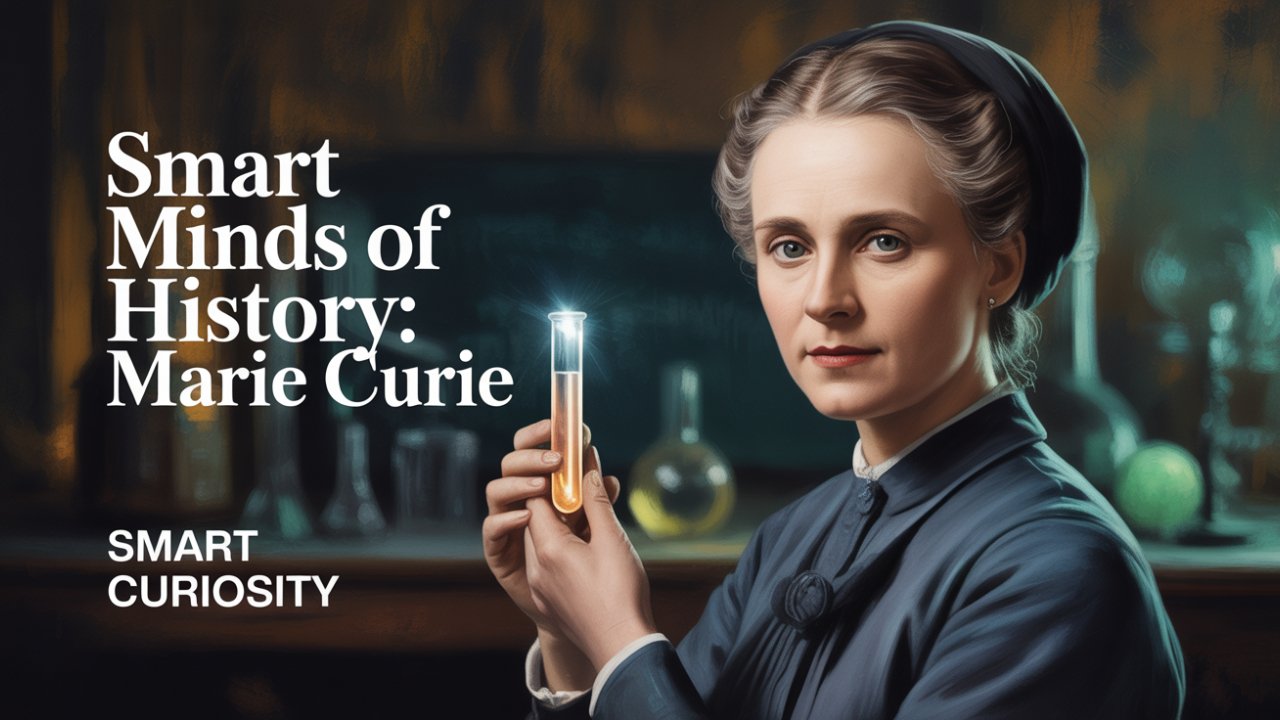She remains the only individual in history to be awarded the Nobel Prize in two distinct scientific disciplines. Her monumental work would not merely redefine our perception of the universe; it would catalyze the creation of entirely new fields of medicine, ultimately saving millions of lives. And yet, the saga of Marie Curie is not a simple narrative of a celebrated genius in pristine laboratories. It is a testament to overcoming insurmountable barriers. It is the story of a woman who, systematically denied a formal education in her homeland, commenced her world-altering research in what was, for all intents and purposes, a leaky, derelict shed. This is the chronicle of how one of history’s most formidable intellects, armed with little more than an indomitable will, conquered poverty, systemic prejudice, and devastating personal tragedy to illuminate the world. This is the story of a revolution that began in darkness.
Have you ever truly contemplated the anatomy of genius? It does not always reside within the hallowed, immaculate halls of prestigious universities. Sometimes, genius manifests as a quiet, unyielding refusal to accept the world as it is presented. For Marie Curie, genius was a relentless, all-consuming fire. It was this internal blaze that propelled her from a life of cultural oppression to the intellectual epicenter of Paris, and it was this same fire that compelled her to interrogate the fundamental laws of physics that the rest of the scientific community accepted as dogma. Her work was so profound, so elemental, that over a century later, her personal notebooks remain too intensely radioactive to be handled without protective shielding. This is the story of the mind behind that radioactivity and the woman who would ultimately pay the supreme price for her discovery.
The Polish Spark
Our narrative begins not in France, but in Warsaw, Poland, on November 7th, 1867. This was the birthplace of Maria Salomea Skłodowska, the youngest of five children. Her world was defined by occupation. Warsaw languished under the dominion of the Russian Empire, which was engaged in a systematic effort to erase Polish culture and identity. The Polish language was suppressed, and the pursuit of intellectual freedom was a dangerously subversive act. But within the Skłodowski household, the acquisition of knowledge became a form of quiet, dignified rebellion.
Her father, Władysław, a teacher of mathematics and physics, instilled in all his children a profound reverence for learning. He would bring home laboratory equipment from his school, transforming their modest apartment into a sanctuary of scientific inquiry. For the young Maria, these esoteric glass tubes and measuring devices were a source of endless fascination. Even as a child, she demonstrated a startlingly acute intellect and a prodigious memory.
But this intellectual haven was perpetually shadowed by hardship. The family endured constant political scrutiny and financial instability. Then, when Maria was just a young girl, her eldest sister, Zosia, succumbed to typhus. A mere four years later, her mother was lost to tuberculosis. These profound losses etched a permanent mark upon Maria, forging within her a steely resilience and a deeply serious, contemplative nature. She channeled her grief into her studies, finding solace in the logical, predictable cosmos of science. She was nothing short of brilliant, graduating from her secondary education at just 16, at the top of her class and decorated with a gold medal. But for all her demonstrated talent, her path forward was barred. The University of Warsaw did not admit women. For a girl, regardless of her intellectual gifts, a higher education in her own country was an impossibility.
A Pact for a Dream
Confronted by this institutional dead end, most individuals would have conceded defeat. But Maria Skłodowska was not most people. If the official gateways to knowledge were bolted shut, she resolved to find an alternative route. She enrolled in a clandestine, underground educational network known as the “Flying University.” It was an illicit, nomadic institution that convened classes in secret locations across Warsaw, perpetually shifting to evade the Tsarist authorities. It was here, in direct defiance of an empire, that Maria kept her intellectual flame alive.
She and her older sister, Bronia, nurtured a shared, seemingly impossible ambition: to travel abroad and attain a legitimate university degree. They fixed their aspirations on Paris and its renowned university, the Sorbonne. The singular obstacle was their profound lack of funds. So, the two sisters forged a pact. Maria would work as a governess and tutor in Poland, sending her earnings to Paris to finance Bronia’s medical studies. Once Bronia was an established doctor, she would, in turn, underwrite Maria’s education.
For the next five arduous years, Maria deferred her own ambitions, laboring in the households of affluent families. The work was often isolating and intellectually stultifying. Yet, in her precious spare time, she clandestinely devoured books on physics, chemistry, and mathematics, engaged in a rigorous curriculum of her own design. It was a long, quiet, unheralded battle, sustained by sheer willpower. She was biding her time, her gaze fixed on the promise of Paris. In 1891, the long-awaited letter arrived. Bronia, now a physician and married, summoned her sister. It was her turn. At 24 years of age, Maria packed her belongings and boarded a train for France, leaving her homeland behind to pursue a dream that the majority of the world believed a woman had no right to entertain.
The City of Light and the Man of Science
When Maria arrived in Paris in 1891, she matriculated at the Sorbonne and began using the French version of her name: Marie. Her new existence was punishingly austere. She resided in a series of tiny, unheated garret rooms, subsisting on little more than buttered bread and tea. She was frequently so cold that she was forced to pile all of her clothing onto her bed for insulation. Intellectually, however, she had never felt more alive. After years of deferred ambition, she threw herself into her studies with a ferocity that bordered on fanatical.
Her brilliance was too profound to be overlooked. In 1893, she earned her master’s degree in physics, finishing first in her class. The following year, she secured a second degree in mathematics, ranking second. Her academic excellence earned her a commission to investigate the magnetic properties of different steels. There was only one complication: she required laboratory space.
A colleague recommended she consult a French physicist named Pierre Curie, who might have room in his lab. Pierre was the laboratory chief at the School of Physics and Chemistry, a brilliant but deeply unconventional scientist in his own right. Their meeting was not a storybook romance; it was a convergence of intellects. They immediately recognized in one another a shared, profound, and all-encompassing passion for science. He was an outsider who held official accolades in low esteem, and she was a destitute immigrant woman navigating a world dominated by men.
Pierre was utterly captivated by Marie’s intense focus and formidable intellect. He had discovered an equal, a collaborator he had never imagined possible. He proposed marriage, but Marie hesitated, as her long-term plan had always been to return to Poland and contribute to her homeland. But Pierre was persistent, even offering to relocate to Poland with her. Ultimately, their shared devotion to science and to each other prevailed. They were married in a simple, non-religious ceremony in July 1895. In lieu of a wedding dress, Marie wore a practical, dark blue outfit that could double as a laboratory uniform. For their honeymoon, they purchased two bicycles and spent the summer cycling through the French countryside. This quiet, unassuming union marked the genesis of one of the most consequential partnerships in the annals of science.
The Mystery in the Shed
In 1896, the scientific world was electrified by a peculiar discovery made by German physicist Wilhelm Röntgen: mysterious “X-rays” capable of penetrating solid matter. Shortly thereafter, a French physicist, Henri Becquerel, stumbled upon an even stranger phenomenon. He observed that uranium salts, entirely on their own, spontaneously emitted rays analogous to X-rays, without any external energy source. These “Becquerel rays” constituted a scientific enigma, yet most researchers, their attention captured by X-rays, largely ignored them.
Marie Curie, however, was searching for a doctoral thesis topic and found herself completely captivated. From where did this energy originate? What was it? It was a bold and unfashionable choice. While the scientific community pursued the sensational X-rays, Marie chose to investigate the faint, cryptic emissions from uranium.
To do this, she employed an ingenious device Pierre and his brother had invented years prior: a highly sensitive electrometer capable of measuring minute electrical charges. Marie meticulously quantified the emissions from various uranium compounds. She swiftly determined that the intensity of the radiation was dependent solely on the quantity of uranium present. This led to a radical suggestion: the radiation was not the product of a chemical interaction between atoms, but was emanating from within the atoms themselves. This was a revolutionary concept. For centuries, the atom was held to be the indivisible, fundamental building block of matter. Marie’s hypothesis implied they were all mistaken.
Then, her investigation took an astonishing turn. She tested a mineral called pitchblende, the primary ore from which uranium is extracted. Logically, the raw ore should have been less radioactive than the purified uranium. But her electrometer revealed the opposite. The pitchblende was dramatically, inexplicably more radioactive. She re-checked her measurements repeatedly, convinced of an error. There was none. The only logical conclusion was that the pitchblende must contain another substance a new, undiscovered element, present in trace amounts, that was exponentially more radioactive than uranium.
When she presented her findings to Pierre, he was so enthralled that he abandoned his own research to join her quest. He immediately grasped the monumental implications. The Sorbonne, however, was less than accommodating. They granted the Curies the use of an abandoned shed a former medical school dissecting room with a leaking roof, no heating, and hazardous ventilation. It was within this miserable, drafty structure that they would begin to re-write the laws of physics.
Unlocking the Atom
The work that followed was absolutely Herculean. To validate their hypothesis, the Curies needed to chemically isolate this theoretical new element. The challenge was that it existed in microscopic quantities within tons of pitchblende ore. The task was akin to searching for a single, specific grain of sand on an entire coastline.
They secured a donation of several tons of pitchblende waste from a mining academy in Austria, and their shed was soon crowded with enormous vats. The process was painstakingly manual and physically brutal. Marie spent her days in the courtyard, stirring huge, boiling cauldrons of crushed ore and chemicals with an iron rod nearly as tall as she was. It was a relentless cycle of fractional crystallization, breaking the ore down, step by agonizing step.
After each stage of refinement, Marie would carry a sample back into the shed to measure its radioactivity. This invisible energy was their solitary guide, signaling whether they were closing in on their quarry. The work was physically punishing and, though they were unaware of it at the time, lethally dangerous. The shed filled with noxious fumes, and all the while, they were unknowingly subjecting themselves to massive doses of radiation. Marie would later write of the strange, ethereal blue-green luminescence the materials emitted in the dark. They would leave the highly radioactive samples on their workbenches and sometimes return at night just to gaze at the faint, ghostly light, which she described as “a source of new and delightful pleasure.”
Through this heroic, obsessive effort, they methodically narrowed their search. They discovered that two distinct chemical fractions were exhibiting intense radioactivity. One behaved chemically like the element bismuth, the other like barium. This implied they had not found one new element, but two.
Two Elements, One Revolution
In July of 1898, after only a few months of this exhausting labor, the Curies published their first announcement. They presented a paper on the new, highly radioactive substance they had partially isolated. In a patriotic tribute to her beleaguered homeland, Marie named it “polonium.” It was in this seminal paper that they introduced a new term to describe the phenomenon itself: “radioactivity.”
But they knew their second discovery was even more extraordinary. It was far more elusive and possessed a radioactivity of an entirely different order of magnitude. A few months later, on December 26, 1898, they announced its existence. This substance was so powerfully radiant they named it “radium.”
The scientific establishment remained skeptical. Announcing new elements is one thing; providing definitive proof is another. To convince the world, the Curies had to isolate pure radium and determine its atomic weight. This would necessitate processing not just kilograms, but tons of ore. For the next four years, this mission became Marie’s singular obsession.
Finally, in 1902, after processing several tons of pitchblende, Marie succeeded in isolating one-tenth of a gram of pure radium chloride. It was an almost impossibly small quantity, but it was sufficient. She precisely measured its atomic weight, cementing its place on the periodic table. Radium was real.
This discovery did more than merely add two elements to a chart. It shattered a 2,000-year-old paradigm of the atom as solid, stable, and indivisible. Radium was spontaneously emitting enormous quantities of energy, seemingly from nothing, while transmuting into other elements in the process. This proved that the atom was not fundamental it had an internal structure, and it could decay. The Curies had, almost incidentally, unlocked the door to the subatomic world and inaugurated the nuclear age.
A Prize and a Prejudice
By 1903, the Curies’ work had sent seismic shocks through the world of science. The Nobel Prize committee began to take notice. That year, the French Academy of Sciences nominated Henri Becquerel and Pierre Curie for the Nobel Prize in Physics. Conspicuously, Marie’s name was omitted.
It was her initial hypothesis, her coining of the term “radioactivity,” and her back-breaking labor that had driven the discovery, but the overwhelmingly male establishment could not conceive of a woman as the primary intellectual force. She was perceived as merely her husband’s assistant.
This was an injustice Pierre Curie refused to tolerate. When an influential friend on the committee alerted him to the omission, Pierre wrote back immediately and unequivocally. He declared that any award for the discovery of radioactivity that did not include Marie was a travesty, and that he would refuse to accept it under such terms. His principled stand forced the committee’s hand. Marie’s name was belatedly added to the nomination.
In December 1903, the Nobel Prize in Physics was jointly awarded to Henri Becquerel, Pierre Curie, and Marie Curie. With that, Marie Curie became the first woman in history to win a Nobel Prize. The prize brought them global fame and desperately needed financial resources. They could finally hire a laboratory assistant and focus properly on their research. Pierre was granted a professorship at the Sorbonne, and for the first time, Marie was given an official paid title: Chief of the Laboratory. It appeared that, after years of relentless struggle, they had finally achieved security and recognition. But their moment of triumph would be tragically brief.
Tragedy and Resolve
On April 19, 1906, on a dark, rain-slicked day in Paris, Pierre Curie was crossing a busy street when he slipped and fell directly into the path of a heavy, horse-drawn carriage. He was killed instantly. Marie’s world disintegrated. In a single moment, she had lost her husband, her most intimate friend, and her greatest scientific collaborator.
The world expected her to quietly fade into obscurity, a grieving widow whose work would be posthumously credited to her husband. But they had profoundly underestimated Marie Curie. She poured her overwhelming despair into her private diary but also summoned a new, formidable resolve. She vowed to continue, alone, the scientific mission they had begun together.
The French government offered her a widow’s pension. She refused it. She did not want charity; she wanted a laboratory. In a move that was unprecedented at the time, the Sorbonne offered her Pierre’s vacant professorship. On May 13, 1906, Marie Curie became the first woman to ever hold such a position at the illustrious university.
Her inaugural lecture was a major public event. The hall was packed with students, academics, and journalists. Many likely expected a sentimental, tearful tribute to her late husband. Instead, Marie walked to the podium, waited for the extended applause to subside, and began her lecture with the precise sentence where Pierre had concluded his last. It was a quiet, unambiguous, and powerful statement: the work would go on. And she would be the one to lead it.
A Second Crown, A Public Scandal
In the years following Pierre’s death, Marie demonstrated that she was not merely a partner in genius, but a towering scientific force in her own right. She dedicated herself to the arduous task of isolating radium in its pure, metallic state, a feat she finally accomplished in 1910, silencing any lingering doubters about her individual contributions.
Her work cemented her status as one of the world’s preeminent scientists. In 1911, the Nobel committee recognized her again this time awarding her the Nobel Prize in Chemistry. There was no debate about her inclusion. Marie Curie became the first person in history to win two Nobel Prizes, and to this day, she remains the only person to have won in two different scientific fields.
But this unparalleled triumph was poisoned by a vicious public scandal. As a widow, Marie had formed a close intellectual and personal relationship with a fellow physicist, Paul Langevin, a brilliant but unhappily married man. When their affair was discovered, the French tabloid press, fueled by rampant xenophobia and misogyny, attacked her with savage intensity. They portrayed Marie not as a scientific titan, but as a foreign interloper and a homewrecker. A mob even surrounded her house, terrorizing her and her two young daughters.
The scandal erupted just as her second Nobel Prize was being announced. Even the Nobel committee grew anxious. One member wrote to her, suggesting she not attend the award ceremony in Stockholm. Marie’s response was swift and resolute. She would be there. She wrote back, stating that “the prize has been given to her for her discovery of polonium and radium” and that “there is no relation between her scientific work and the facts of her private life.”
She attended the ceremony and accepted her prize with her head held high. But the public ordeal took a severe toll on her physical and mental health. It was a brutal reminder that even as a double Nobel laureate, she was still judged by a crueler, more intrusive standard simply for being a woman. Yet, even this could not break her. She recovered, returned to her laboratory, and turned her focus to her next great project: applying her science to save human lives.
The War Effort’s Angel
In 1914, the First World War engulfed Europe in darkness. Scientific research ground to a halt as scientists were conscripted for the front lines. But Marie knew her discoveries had a vital role to play. On the brutal battlefields, surgeons often operated blindly, unable to locate bullets or shrapnel embedded within a soldier’s body, leading to countless unnecessary amputations and deaths. Marie realized that mobile X-ray units could deliver this life-saving diagnostic technology directly to the front.
With no initial government support, she took matters into her own hands. She persuaded wealthy patrons to donate automobiles and manufacturers to provide X-ray equipment. She learned to drive, took courses in auto mechanics, and crammed lessons in anatomy. She personally converted these vehicles into mobile radiological stations, which French soldiers affectionately nicknamed “petites Curies,” or “Little Curies.”
And she did not merely organize from a safe distance. Accompanied by her teenage daughter, Irène, who served as her assistant, Marie drove the Little Curies herself, right up to casualty clearing stations near the front lines. There, they would set up the heavy equipment in field hospitals and work tirelessly, taking X-rays to guide the hands of surgeons.
Over the course of the war, she established 20 mobile X-ray units and equipped 200 more in hospitals. She personally trained 150 women to serve as radiological operators. It is estimated that her Little Curies were used in the treatment of over a million wounded soldiers. She even attempted to donate her gold Nobel Prize medals to the French war effort, though the national bank refused to melt them down. And all the while, she and Irène were exposed to hazardous levels of radiation with no protective gear. Despite these incredible contributions, after the war, Marie Curie received no formal honor or recognition from the French government for her service.
The Legacy of Light
After the war, Marie returned to her Radium Institute in Paris, transforming it into a world-class center for the study of physics and chemistry. Her work had already redefined the fundamental nature of matter, but its most enduring legacy lay in the field of medicine.
The powerful energy emitted by radium was now being harnessed to combat cancer. The field of radiation therapy initially known as “Curietherapy” was born directly from her discovery. Radium’s ability to destroy diseased cells became a cornerstone of modern oncology, saving and extending millions of lives to this day. Her fundamental research provides the foundation for technologies like modern radiological imaging and the entire field of nuclear medicine.
Her legacy also became a familial one. Her daughter, Irène Joliot-Curie, matured into a brilliant scientist in her own right. In 1935, Irène and her husband were jointly awarded the Nobel Prize in Chemistry for their discovery of artificial radioactivity, making the Curies the most decorated Nobel family in history.
But perhaps Marie Curie’s most profound legacy was that of a pioneer. She entered a world seemingly determined to exclude her. She faced institutional sexism, xenophobia, and professional jealousy at every turn. When a university denied her entry, she helped create a secret one. When the establishment attempted to deny her credit, her husband refused to allow it. When they tried to shame her into declining a Nobel Prize, she accepted it with unshakeable dignity. She proved, through sheer force of will, that genius knows no gender. She became a transcendent inspiration for generations of women in science, technology,engineering, and mathematics.
Marie Curie died on July 4, 1934, at the age of 66. The cause of death was aplastic anemia, a blood disease almost certainly contracted from her decades of cumulative exposure to radiation. The very elements she had discovered, the source of her renown, were also the instruments of her death. Even today, her scientific notebooks from the 1890s are so intensely radioactive they must be stored in lead-lined boxes and can only be handled by researchers in protective clothing.
She was a figure of remarkable contradictions: a quiet and reserved individual who became a global celebrity; a pure researcher dedicated to fundamental discovery whose work yielded immense practical applications. In the words of Albert Einstein, she was “the only one of all celebrated beings whom fame has not corrupted.” She gifted her discoveries freely to the world, refusing to patent the process for isolating radium because she believed scientific knowledge should belong to all of humanity.
In 1995, her remains were exhumed and re-interred in the Panthéon in Paris, the final resting place of France’s most revered national heroes. She was the first woman to be honored there on her own merits. The story of Marie Curie is more than the biography of a scientist. It is a testament to the power of human curiosity and the endurance of the human spirit. She began her journey in a dilapidated shed and ended it as one of the most consequential figures of the 20th century. Her life, a beacon of discovery, continues to illuminate our world, reminding us of her own profound words: “Nothing in life is to be feared, it is only to be understood.”
If you were inspired by the incredible life of Marie Curie, please hit that like button and subscribe to Smart Minds of History for more stories about the people who shaped our world. Let us know in the comments which historical genius you’d like to see us cover next. Thanks for watching.





